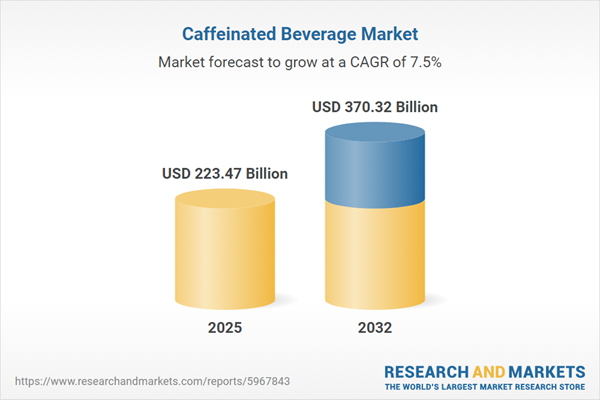Speak directly to the analyst to clarify any post sales queries you may have.
The global caffeinated beverage market is evolving rapidly, driven by consumer demand for health-conscious choices, convenience, and premium experiences. Senior decision-makers need timely, actionable intelligence to navigate this dynamic environment and position their businesses for success.
Market Snapshot: Caffeinated Beverage Market Growth and Trends
The Caffeinated Beverage Market grew from USD 207.55 billion in 2024 to USD 223.47 billion in 2025. It's projected to maintain a strong 7.50% CAGR, reaching USD 370.32 billion by 2032.
Growth is shaped by shifting consumer habits, new product formats, and the integration of advanced technologies in both manufacturing and consumer engagement. The blend of tradition and innovation is expanding demand across global demographics, making market intelligence essential for forward-looking leaders.Scope & Segmentation of the Global Caffeinated Beverage Market
This report delivers an in-depth assessment of market dynamics, emerging opportunities, and challenges facing the global caffeinated beverage sector. Segmentation provides clear insights into demand patterns, innovation drivers, and competitive positioning.
- Product Types: Carbonated soft drinks; ground coffee; instant coffee; pods and capsules; ready-to-drink coffee; energy drinks (bottled and canned); powder mixes; ready-to-drink tea.
- Distribution Channels: Off-trade (convenience stores, groceries and supermarkets, online retail); on-trade (cafes, restaurants, hotels, and pubs).
- Packaging Formats: Bottles (glass and PET); cans (aluminum and steel); coffee grounds and instants; pods and capsules; powdered mixes.
- Caffeine Levels: High, low, medium, very high.
- Geographic Regions: Americas (North and Latin America); Europe, Middle East, and Africa; Asia-Pacific.
- Featured Companies: The Coca-Cola Company, PepsiCo, Inc., Nestlé S.A., Keurig Dr Pepper Inc., Red Bull GmbH, Monster Beverage Corporation, Starbucks Corporation, JDE Peet’s N.V., Suntory Beverage & Food Limited, Luigi Lavazza S.p.A.
Key Takeaways for Senior Decision-Makers
- Rising health awareness is driving brands to offer beverages with functional ingredients, lower sugar content, and natural alternatives, fueling innovation across categories.
- Premiumization is influencing purchasing decisions, with consumers valuing bespoke blends, unique origin coffees, and limited-edition energy drink formulations aligned to quality perceptions.
- Digital transformation is empowering brands to reach consumers via direct-to-consumer channels, personalized marketing, and enhanced engagement through apps and social media, boosting transparency and loyalty.
- Sustainability expectations are prompting investments in ethical sourcing, recyclable packaging, and end-to-end traceability to reinforce competitive positioning and respond to regulatory shifts.
- Regional diversification is critical, as consumer preferences, regulatory requirements, and distribution landscapes vary significantly among the Americas, EMEA, and Asia-Pacific, necessitating tailored strategies.
Tariff Impact: Navigating Cost and Trade Disruptions
Recent U.S. tariff adjustments introduced new cost pressures for companies dependent on imported raw materials within the caffeinated beverage supply chain. Companies have responded by realigning their supplier portfolios, strengthening local procurement, and renegotiating contracts to contain volatility. These measures have motivated strategic nearshoring, collaboration with local bottlers, and further adoption of advanced analytics to optimize inventories and minimize disruption. Some brands have managed price pressures through value-focused product lines and private-label alternatives.
Methodology & Data Sources
This analysis leverages a balance of primary research—executive interviews, expert panels, and industry consultations—and secondary research, such as regulatory filings, trade magazines, and academic publications. Data triangulation methods and cross-validation ensure reliability, while structured segmentation and scenario analysis deliver actionable clarity.
Caffeinated Beverage Market: Why This Report Matters
- Enables informed decision-making by providing a robust framework for understanding macro and micro market shifts.
- Empowers senior leaders with actionable insights to align innovation, supply chain agility, and portfolio strategies with evolving consumer needs.
- Facilitates risk mitigation and strategic growth planning in an environment shaped by health, sustainability, and international trade trends.
Conclusion
A nuanced approach to market segmentation, innovation, and regional adaptation is crucial to sustainable growth in the global caffeinated beverage industry. Strategic agility and data-driven insights will equip leaders to capitalize on emerging opportunities and address operational challenges efficiently.
Additional Product Information:
- Purchase of this report includes 1 year online access with quarterly updates.
- This report can be updated on request. Please contact our Customer Experience team using the Ask a Question widget on our website.
Table of Contents
3. Executive Summary
4. Market Overview
7. Cumulative Impact of Artificial Intelligence 2025
Companies Mentioned
The companies profiled in this Caffeinated Beverage market report include:- The Coca-Cola Company
- PepsiCo, Inc.
- Nestlé S.A.
- Keurig Dr Pepper Inc.
- Red Bull GmbH
- Monster Beverage Corporation
- Starbucks Corporation
- JDE Peet’s N.V.
- Suntory Beverage & Food Limited
- Luigi Lavazza S.p.A.
Table Information
| Report Attribute | Details |
|---|---|
| No. of Pages | 188 |
| Published | October 2025 |
| Forecast Period | 2025 - 2032 |
| Estimated Market Value ( USD | $ 223.47 Billion |
| Forecasted Market Value ( USD | $ 370.32 Billion |
| Compound Annual Growth Rate | 7.5% |
| Regions Covered | Global |
| No. of Companies Mentioned | 11 |









